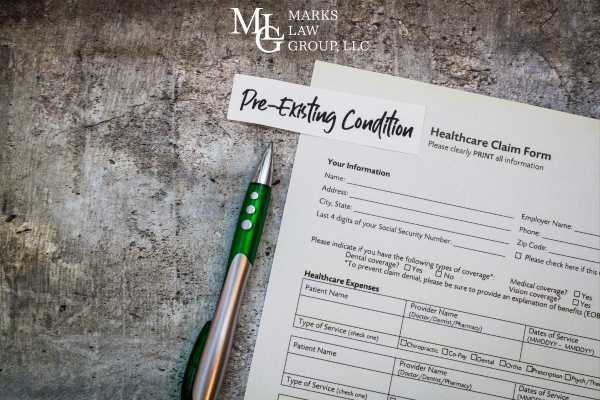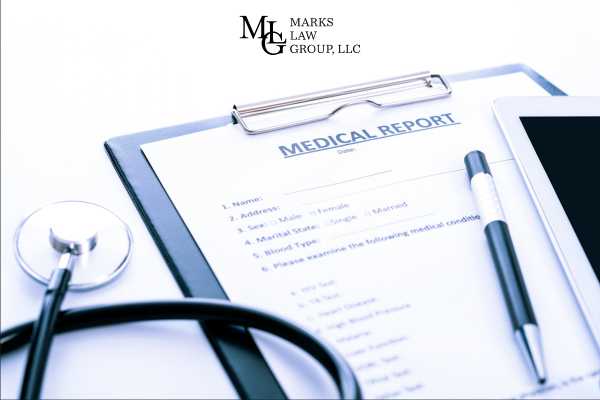When pursuing an injury claim, many individuals wonder how pre-existing conditions might impact their case. Understanding the relationship between pre-existing conditions and injury claims is crucial, as insurance companies and opposing parties may use this information to minimize compensation. Pre-existing conditions can complicate the evaluation of damages, especially if the injury exacerbates a previous health issue or leads to ongoing complications.
Navigating the nuances of an injury claim can be challenging, particularly when pre-existing conditions are involved. If you're unsure how your medical history may affect your claim, consulting with a knowledgeable personal injury lawyer can provide clarity and guidance. Don't let uncertainties hinder your pursuit of justice. Call 678-251-9309 today to learn more about how we can help you effectively navigate your injury claim.
How a Pre-existing Injury Affects Damages in a Personal Injury Claim in Georgia
In Georgia, the impact of a pre-existing injury on damages in a personal injury claim can be significant, influencing both the amount of compensation awarded and the overall outcome of the case. Here’s how pre-existing injuries can affect damages:
Georgia adheres to the "eggshell plaintiff" rule, which means that a defendant is liable for the full extent of a plaintiff's injuries, even if they are more severe due to a pre-existing condition. For instance, if a plaintiff has a pre-existing back injury that is exacerbated by a car accident, the defendant is still responsible for covering the costs of treatment and pain related to the aggravated condition.
Georgia follows a modified comparative negligence system. If the plaintiff is found to be partially at fault for their injuries, their compensation may be reduced by their percentage of fault. This means that if the defendant argues that the pre-existing condition contributed to the plaintiff's injuries, it could impact the determination of liability and the compensation for damages awarded.

While plaintiffs can recover for the full extent of their injuries, insurance adjusters and juries may consider the pre-existing condition when evaluating pain and suffering, medical expenses, and other damages. They may assess whether the accident merely aggravated a prior condition or caused new injuries altogether. Consequently, pre-existing injuries could potentially result in lower damage awards if they are seen as significantly contributing to the overall injury.
How a Pre-existing Condition Can Cause Issues Determining Causation in an Injury Claim
In personal injury claims, establishing causation—the direct link between the accident and the injuries sustained—is crucial for securing compensation. However, when a plaintiff has a pre-existing condition, determining causation can become complex and contentious. Here’s how pre-existing conditions can complicate the causation aspect of an injury claim.
Causation in personal injury cases typically involves demonstrating that the defendant's actions directly resulted in the plaintiff's injuries. This requires clear evidence showing that the injury was not only foreseeable but also caused by the accident.
- Compounding Effects: Pre-existing conditions can make it difficult to ascertain whether the new injury or exacerbation of the condition was directly caused by the accident. If a plaintiff had a prior back injury, for example, it may be hard to determine if the current pain is due to the new accident or the earlier injury.
- Defense Arguments: Defendants and their insurance companies often use pre-existing conditions as a defense strategy. They may argue that the plaintiff’s current symptoms or issues are solely due to the pre-existing condition, rather than the incident in question. This can lead to disputes over the extent to which the accident aggravated the existing condition.
- Medical Evidence: Establishing causation often relies on medical records and expert testimony. However, if the medical documentation of the pre-existing condition is not comprehensive, it can be challenging for the plaintiff to prove how the accident impacted their health. The defense may capitalize on any gaps in medical history to undermine the plaintiff's claims.
- Difficulty in Quantifying Damages: When causation is unclear, it becomes more complicated to quantify damages for an injury claim. Courts may need to apportion damages between the new injuries and the existing condition, leading to potential reductions in compensation. The uncertainty surrounding how much of the injury is attributable to the accident can weaken the plaintiff’s case.
- Comparative Negligence: In some jurisdictions, comparative negligence rules may come into play. If a plaintiff is found partially responsible for their injuries due to a pre-existing condition, this could reduce the damages awarded. For instance, if a plaintiff failed to seek treatment for a pre-existing injury, the court may decide that they share some responsibility for their ongoing pain.
Pre-existing conditions can significantly complicate the determination of causation in personal injury claims. Plaintiffs must be prepared to present strong evidence linking their injuries to the accident while addressing potential defense arguments regarding their prior health issues. By effectively documenting their conditions and collaborating with medical experts, individuals can bolster their claims and improve their chances of securing appropriate compensation.
Tips for Factoring in Pre-existing Conditions When Compiling Medical Evidence for Your Injury Claim
When pursuing an injury claim, pre-existing conditions can complicate the process, affecting how your injuries are viewed by insurance adjusters and courts. To ensure that your claim is thoroughly supported, here are some tips for compiling medical evidence while factoring in pre-existing conditions.
- Gather Comprehensive Medical Records: Start by collecting all relevant medical records, not only from the time of the accident but also from before it. Obtain records of treatments and diagnoses related to your pre-existing condition. Include reports from doctors that detail your condition and any previous symptoms as well as any medications you may take for it.
- Document the Impact of the Accident: Clearly document how the accident has affected your pre-existing condition. Note any new symptoms or exacerbation of existing symptoms since the accident, and record any changes or additions to your treatment plan.
- Seek Expert Medical Opinions: Consult with medical professionals who can provide insights into your injuries and how they relate to your pre-existing condition. Their expert testimony can be invaluable in establishing causation and the impact of the accident.
- Maintain a Detailed Journal: Keep a journal documenting your daily experiences related to your injury and pre-existing condition. Track any changes in pain or discomfort, and relate them to specific activities or incidents. Note any difficulties you face in daily activities due to the accident.
- Collect Supporting Documentation: In addition to medical records, gather other documentation that can support your claim:
- Witness Statements: If applicable, obtain statements from family or friends who can attest to the changes in your condition since the accident.
- Photographic Evidence: Capture images that illustrate the impact of your injuries, especially if they affect your ability to engage in activities you previously enjoyed.
- Clarify Causation with Your Attorney: Work closely with your personal injury attorney to clarify the connection between your injuries and the accident. Ensure that your legal representation understands how to frame your case, considering both the pre-existing condition and the injuries sustained.

Getting compelling evidence for an injury claim that involves pre-existing conditions requires thoroughness and clarity. By gathering comprehensive records, seeking expert opinions, and documenting your experiences, you can create a compelling case that highlights the impact of the accident on your health.
How Insurance Adjusters View a Pre-Existing Condition When Evaluating Injury Claims
Insurance adjusters play a pivotal role in assessing injury claims and determining the compensation that may be awarded to claimants. When it comes to pre-existing conditions, adjusters approach evaluations with caution and a critical eye. Here’s how they typically view pre-existing conditions during the claims process.
Understanding the Pre-existing Condition
Insurance adjusters recognize that pre-existing conditions are medical issues that existed prior to the accident. These conditions can range from chronic illnesses and previous injuries to degenerative diseases. Adjusters will thoroughly review medical records to identify any such conditions, as they can significantly impact the assessment of the claim.
- Causation Analysis: Adjusters assess whether the current injury can be directly linked to the accident or if it stems from the pre-existing condition. They look for critical evidence that delineates the impact of the accident on the claimant's health. If there is ambiguity, adjusters may downplay the accident's role in the injuries sustained.
- Medical Records Examination: A comprehensive review of the claimant’s medical history is standard practice for adjusters. They seek to understand the nature of the pre-existing condition, treatment received, and the claimant’s functional status before and after the incident. This examination helps adjusters determine whether the accident aggravated the existing condition or if the symptoms are consistent with prior health issues.
- Comparative Negligence: Adjusters may consider whether the claimant’s pre-existing condition contributed to the current injuries. If they believe that the pre-existing condition played a significant role, they might argue for reduced liability or compensation based on the principle of comparative negligence.
- Impact on Settlement Amount: Pre-existing conditions can affect the overall settlement amount. Adjusters may propose lower settlement offers if they determine that the claimant’s injuries are largely attributable to prior health issues rather than the accident. They may also factor in the potential for ongoing treatment related to the pre-existing condition.
- Expert Opinions: Insurance adjusters often rely on medical expert evaluations to gain insights into the pre-existing condition and its relation to the claim. If an expert provides an opinion that supports the insurance company’s stance on the pre-existing condition, it can significantly influence the outcome of the claim.
Insurance adjusters view pre-existing conditions as critical factors in evaluating injury claims. They meticulously analyze the claimant's medical history and current condition to determine causation and the extent of liability. By being proactive and thorough in documenting their injuries and medical history, claimants can enhance their chances of a fair evaluation from insurance adjusters.
Have Questions About Your Injury Claim? Contact Us for Legal Guidance
Understanding how pre-existing conditions impact your injury claim is vital to securing the compensation you deserve. While these conditions can complicate your case, they do not automatically disqualify you from receiving damages. With the right legal support, you can effectively present your situation and advocate for your rights.
If you're facing challenges related to a pre-existing condition in your injury claim, don't hesitate to seek professional guidance. Contact our law firm today to discuss your case and explore your options for pursuing the compensation you need. Let us help you navigate this complex process with confidence.
